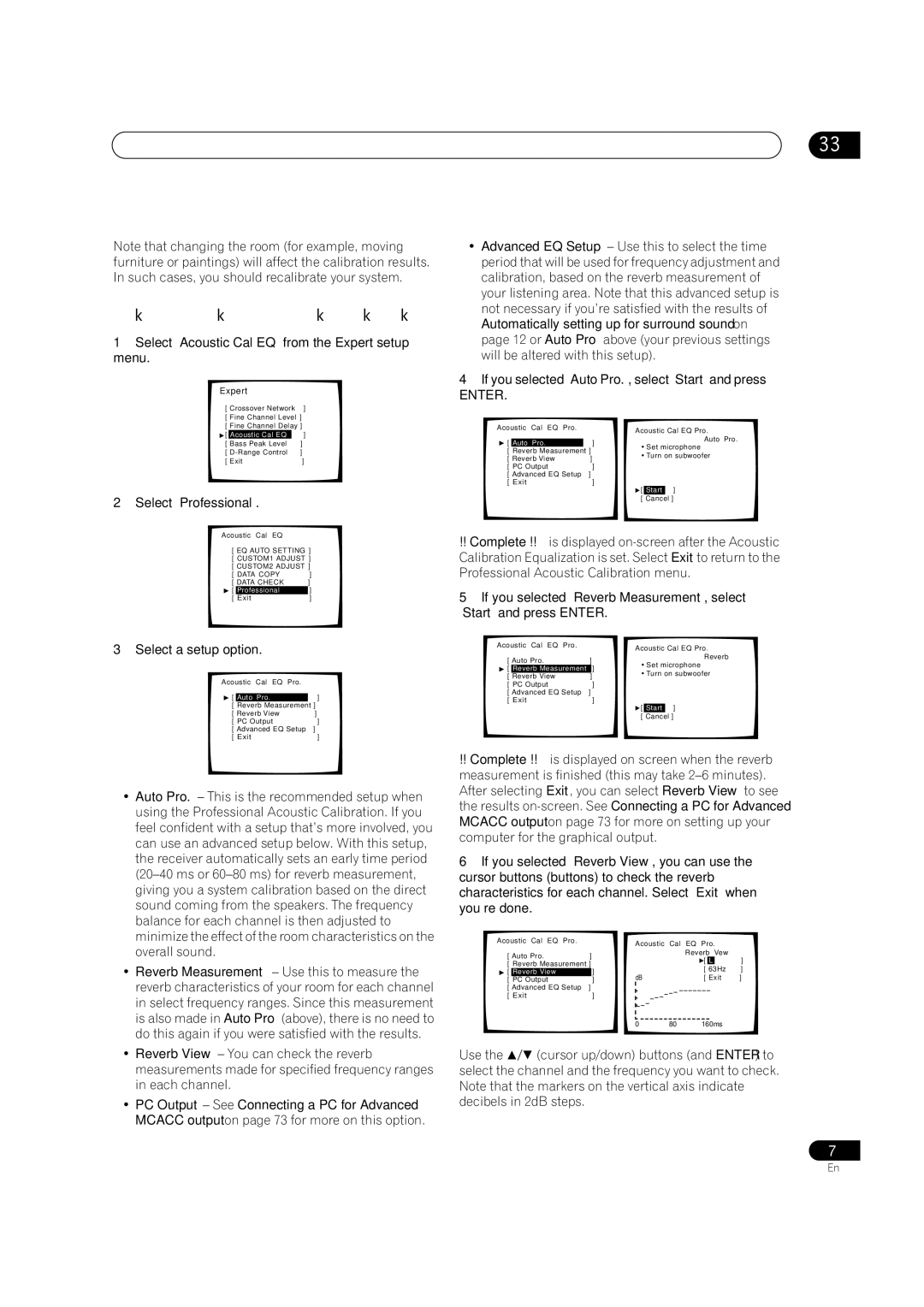
Advanced setup
Note that changing the room (for example, moving furniture or paintings) will affect the calibration results. In such cases, you should recalibrate your system.
Using Professional Acoustic Calibration
1Select ‘Acoustic Cal EQ’ from the Expert setup menu.
Expert
[ Crossover Network ]
[ Fine Channel Level ]
[ Fine Channel Delay ]
[ | Acoustic Cal EQ | ] |
[ Bass Peak Level | ] | |
[ | ] | |
[ Exit | ] | |
2 Select ‘Professional’.
Acoustic Cal EQ
[ EQ AUTO SETTING ] [ CUSTOM1 ADJUST ] [ CUSTOM2 ADJUST ]
[ DATA COPY | ] | |
[ DATA CHECK | ] | |
[ | Professional | ] |
[ | Exit | ] |
3 Select a setup option.
Acoustic Cal EQ Pro. |
| ||
[ |
|
| ] |
Auto Pro. | |||
[ | Reverb Measurement | ] | |
[ Reverb View | ] | ||
[ PC Output | ] | ||
[ Advanced EQ Setup | ] | ||
[ Exit | ] | ||
•Auto Pro. – This is the recommended setup when using the Professional Acoustic Calibration. If you feel confident with a setup that’s more involved, you can use an advanced setup below. With this setup, the receiver automatically sets an early time period
•Reverb Measurement – Use this to measure the reverb characteristics of your room for each channel in select frequency ranges. Since this measurement is also made in Auto Pro (above), there is no need to do this again if you were satisfied with the results.
•Reverb View – You can check the reverb measurements made for specified frequency ranges in each channel.
•PC Output – See Connecting a PC for Advanced MCACC output on page 73 for more on this option.
11
•Advanced EQ Setup – Use this to select the time period that will be used for frequency adjustment and calibration, based on the reverb measurement of your listening area. Note that this advanced setup is not necessary if you’re satisfied with the results of Automatically setting up for surround sound on page 12 or Auto Pro above (your previous settings will be altered with this setup).
4If you selected ‘Auto Pro.’, select ‘Start’ and press
ENTER.
Acoustic Cal EQ Pro. |
| Acoustic Cal EQ Pro. | |||||
|
|
|
|
|
| Auto Pro. | |
[ | Auto Pro. |
| ] | ||||
| • Set microphone | ||||||
[ Reverb Measurement ] | |||||||
• Turn on subwoofer | |||||||
[ Reverb View | ] | ||||||
|
|
| |||||
[ PC Output | ] |
|
|
| |||
[ Advanced EQ Setup | ] |
|
|
| |||
[ Exit | ] | [ |
| ] | |||
|
|
|
| Start | |||
|
|
|
| [ | Cancel | ] | |
!!Complete !! is displayed
5If you selected ‘Reverb Measurement’, select ‘Start’ and press ENTER.
Acoustic Cal EQ Pro. |
| Acoustic Cal EQ Pro. | ||||
[ Auto Pro. | ] |
|
| Reverb | ||
• Set microphone | ||||||
[ | Reverb Measurement | ] | ||||
• Turn on subwoofer | ||||||
[ Reverb View | ] | |||||
|
|
| ||||
[ PC Output | ] |
|
|
| ||
[ Advanced EQ Setup | ] |
|
|
| ||
[ Exit | ] | [ |
| ] | ||
|
|
| Start | |||
|
|
| [ | Cancel | ] | |
!!Complete !! is displayed on screen when the reverb measurement is finished (this may take
6If you selected ‘Reverb View’, you can use the cursor buttons (buttons) to check the reverb characteristics for each channel. Select ‘Exit’ when you’re done.
Acoustic | Cal EQ Pro. |
| Acoustic | Cal | EQ Pro. |
| |||
|
|
|
|
| |||||
[ Auto Pro. | ] |
|
| Reverb Vew |
| ||||
|
| [ | L |
| ] | ||||
[ Reverb Measurement ] |
|
|
| ||||||
|
| [ 63Hz | ] | ||||||
[ | Reverb View | ] |
|
| |||||
dB |
| [ Exit | ] | ||||||
[ | PC Output | ] |
| ||||||
[ Advanced EQ Setup | ] |
|
|
|
|
|
| ||
[ Exit |
| ] |
|
|
|
|
|
| |
|
|
|
| 0 | 80 | 160ms |
| ||
Use the | (cursor up/down) buttons (and ENTER) to | ||||||||
select the channel and the frequency you want to check. Note that the markers on the vertical axis indicate decibels in 2dB steps.
85
En
